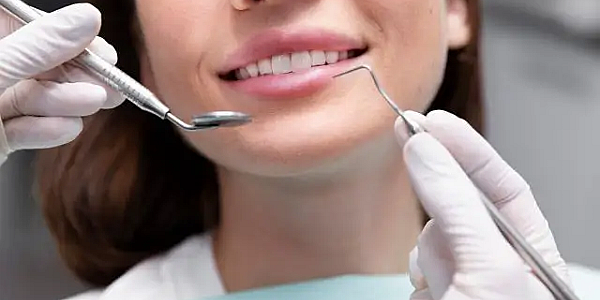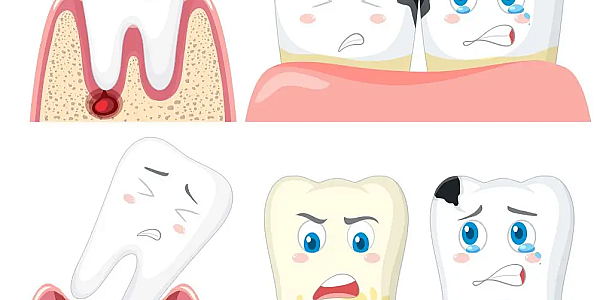Everything you need to know about tooth decay and cosmetic dental fillings: prevention, treatment and care
According to the World Health Organization (WHO), oral cavity diseases affect almost 3.5 billion people worldwide, particularly the poor and vulnerable population. More than 530 million children suffer from untreated caries of primary teeth (baby teeth) and 796 million people are affected by periodontal diseases (1).
Dental caries and periodontal disease represent a major public health problem that directly affects the quality of life, through the loss of natural teeth (30% of Europeans between the ages of 65 and 74 have no natural teeth), according to the WHO (2).
Dental caries is the most widespread non-communicable disease and correlates in children with unfavorable growth patterns, also representing a frequent cause of absence from school or work. Dental caries, directly associated with sugar consumption, generally an unhealthy lifestyle (sweetened or acidic foods and drinks), but also poor oral hygiene, can be largely prevented by simple, low-cost individual interventions, while treatment is expensive and often unavailable in most countries (largely also in Romania) (3).
- More than half of children between the ages of 6 and 8 had decay in at least one of their milk (primary) teeth (4).
- More than half of adolescents between the ages of 12 and 19 had decay in at least one of their permanent teeth (4).
- By age 8, over half of children (52%) had decay in their primary (baby) teeth (4).
- 1 in 4 adults between the ages of 20 and 64 currently have cavities (4).
- Drinking fluoridated water and getting dental sealants (in childhood) prevent cavities and save money by avoiding expensive dental care (4).
1. What are Dental Caries?
Dental caries are damage to the tooth structure caused by bacteria. They can affect both enamel and dentin, causing pain and discomfort. Symptoms include sensitivity to sweet, cold or hot and pain when chewing.
2. How are dental caries formed?
Caries are formed by the demineralization process caused by the acids produced by bacteria. Eating foods high in sugar and carbohydrates accelerates this process. Remineralization , the natural process of repairing tooth enamel, can prevent tooth decay if balanced with demineralization.
Many statistics indicate that, during their lifetime, a significant proportion of the population needs at least one dental or dental filling.
3. Methods of Preventing Dental Caries
- Proper Oral Hygiene: Regular brushing and flossing are essential.
- Healthy Eating: Limiting the consumption of sugar and carbohydrates prevents the formation of acids.
- Fluoridation and Sealing: These dental treatments can protect teeth from decay.
4. What is a Dental Obturation (Fillings)?
Fillings are materials used to repair teeth affected by decay. There are several types of fillings, including amalgam fillings and composite fillings, each with advantages and disadvantages.
5. What types of dental fillings are there?
There are several types of dental fillings available, each with its own characteristics and advantages. Amalgam fillings are a traditional option, recognized for their durability and strength, but they are less esthetic due to their silver color. Composite fillings, on the other hand, are made from a mixture of resins and can be colored to match the natural shade of the teeth, thus providing a more aesthetic solution. Ceramic fillings, usually porcelain, are prized for their natural look and stain resistance, but can be more expensive. Gold fillings, while the most durable and biocompatible, are also the most expensive. The choice of filling type depends largely on patient preference, the location and extent of the caries, and financial considerations.
Our team of dentists prefers aesthetic dental fillings (aesthetic dental fillings) which, in addition to the aesthetic appearance, offer a long life of the dental filling.
6. What should you not do before a dental filling?
Before having a dental filling, there are a few things you should not do to ensure a smooth and effective procedure. You should not consume extremely cold or hot foods or drinks, as these can increase the sensitivity of the affected tooth. Also, avoid eating hard or sticky foods that may cause discomfort or worsen tooth decay. It is also advisable to avoid consuming foods or drinks with a high sugar content, which can accelerate the growth of bacteria and worsen decay. Additionally, avoid smoking or drinking alcohol, as these can affect blood circulation and slow down the post-procedural healing process. Finally, make sure you have proper oral hygiene, brushing and flossing before the procedure to reduce the risk of infection and complications.
5. Cavity Filling Procedure
The cavity filling procedure is a detailed and meticulous process that involves several steps to ensure that the affected tooth is properly repaired. Here is a detailed description of the procedure:
- Consultation and Diagnosis
Before the procedure, the dentist will perform an oral examination and, if necessary, x-rays, to assess the severity of the decay and determine the appropriate treatment method.
- Local Anesthesia
To avoid any discomfort or pain during the procedure, the area surrounding the affected tooth will be anesthetized.
- Removal of the Damaged Part
The dentist will use a dental bur to remove tooth tissue affected by decay. This is a crucial step to prevent further caries progression.
- Cleaning the Affected Area
After removing the damaged part, the affected area will be meticulously cleaned to remove any remaining bacteria and prevent further infection.
- Application of Dental Filling or Dental Obturation
Once the tooth is prepared, the filling material is applied to the cavity. The material can be of different types, such as amalgam or composite, depending on the patient's preferences and the dentist's recommendations.
- Polishing of Fillings (Dental Fillings)
After the filling material is applied, it will be shaped and polished to match the natural contour of the tooth and ensure a comfortable bite.
- Post-Procedural Care Instructions
At the end of the procedure, the patient will receive instructions on how to care for the filled tooth, including recommendations on oral hygiene and nutrition.
- Follow-up Control of Dental Fillings
A follow-up can be scheduled to check the condition of the filling and ensure the tooth is healing properly.
6. Alternatives to Dental Fillings
- Inlays and Onlays : Used for large cavities, providing structural support.
- Dental crowns: They are used when the tooth is severely damaged.
- Root Canal Treatment: It is necessary when the infection has reached the nerve of the tooth.
7. The cost of a Dental Filling?
If you asked yourself "How much does a table seal cost?", with a simple Google search you can see that the cost of seals varies depending on the type of seal and location, being most of the time between 200 RON - 350 RON in Bucharest . Many dental insurances cover some of the costs, but it's good to check the details of your policy.
The prices for dental fillings or aesthetic fillings performed at the DentArbre dental clinic (Bucharest - Sector 2) are as follows:
- Superficial obturation (tooth filling) - 200 RON Schedule an appointment!
- Average obturation (tooth filling) 250 RON Schedule an appointment!
- Deep obturation (tooth filling) 300 RON Schedule an appointment!
- Direct composite veneering 300 RON Schedule an appointment!
8. Conclusion:
Maintaining oral health by preventing and treating cavities is essential to a healthy smile. Dental fillings are an effective solution, but prevention through proper oral hygiene and a healthy diet remains the best approach.
Don't let tooth decay affect your smile! Schedule a dental check-up today and discover how you can maintain optimal oral health.
Bibliographical references
1. World Health Organization (2021). World Health Assembly Geneva Resolution : WHO https://www.who.int/news/item/27-05-2021-world-health-assembly-resolution-paves-the-way-for-better-oral-health-care
2. World Health Organization , Oral Health https://www.who.int/data/gho/data/themes/oral-health-data-portal
3. World Health Organization (WHO) (2017), Sugars and dental cavities .
https://apps.who.int/iris/bitstream/handle/10665/259413/WHO-NMH-NHD-17.12-eng.pdf
4. Centers for Disease Control and Oral Health , Oral Health Fast Facts https://www.cdc.gov/oralhealth/fast-facts/index.html




